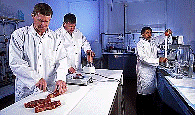United States Department of Agriculture: Agricultural Research Service, Lincoln, Nebraska

Roman L. Hruska U.S. Meat Animal Research Center: Reports
Date of this Version
1993
Document Type
Article
Abstract
The cow uses about 65% of the feed energy used in the production of beef cattle. Of that, about 74% is used for maintenance of the maternal body, 18% for lactation and 8% for pregnancy in the mature, producing beef cow. The growing- finishing animal uses about 35% of the total feed energy used for beef production. In the growing-finishing animal, maintenance costs may vary from 30 to 100% of the total feed energy consumed, with the lower proportion being at high intakes and rates of gain. Typically, in feedlot cattle this value ranges from 30 to 40%, whereas in cattle growing more slowly, such as stocker cattle, maintenance costs represent about 50 to 70% of the total. As a result, energy expenditures for maintenance are relevant to all phases of beef production, but are generally of greater importance in the cow herd.
Numerous breeds of cattle are currently available to beef cattle producers. Large differences among breeds for important traits such as mature size, growth rate, body composition, and milk production have been well documented. To effect improvements in efficiency, both required feed input and product output need critical examination. Differences among breeds or genotypes have also been observed with regard to energy requirements and/or efficiency of energy utilization for maintenance and weight or energy gain. Some of the research efforts at U.S. Meat Animal Research Center in this regard were summarized in the previous Beef Research Progress Report (Ferrell and Jenkins, 1988). Those studies indicated that, in general, there appears to be a positive association between genetic potential for productivity and maintenance requirements. Stated another way, there is an antagonistic relationship between potential productivity and feed requirements for maintenance. Further understanding of relationships between utilization of feed energy and productive potential is needed in order to select appropriate genotypes for given production environments. The objective of the present study was to evaluate the relationship of animal energy expenditures to feed available in diverse genotypes.


Comments
Published in Beef Research Program Progress Report (1993) No. 4 (Part 1): 118